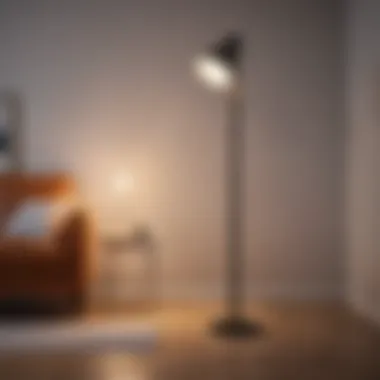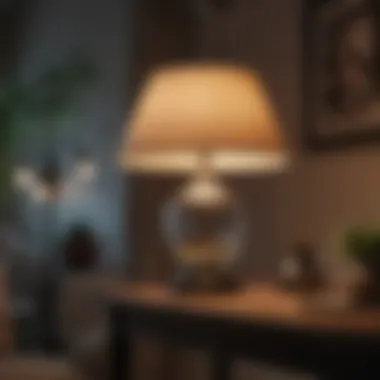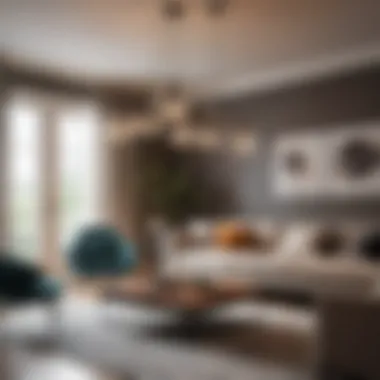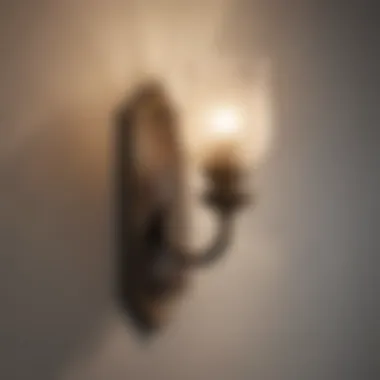Creative Lamp Ideas to Elevate Your Living Room


Intro
In contemporary interiors, lighting plays a vital role in shaping the mood and functionality of living spaces. The right lamp not only illuminates but also complements the overall aesthetic. From minimalistic designs to bold statements, the array of lamps available offers countless possibilities. This article aims to explore various innovative lamp ideas tailored for living rooms, providing readers with insights on selection, positioning, and incorporation of different styles.
Design Inspiration
Current Trends in Interior Design
Modern living spaces often reflect a blend of comfort and sophistication. Current trends lean towards sustainable materials and a focus on natural light. Lamps crafted from bamboo, recycled metals, or organic fabrics are gaining popularity. Additionally, many homeowners are opting for unique shapes and multifunctional designs that serve more than just lighting needs.
For instance, a floor lamp with integrated shelves can provide both illumination and storage, making it a practical choice for smaller living rooms. Another trend highlights the use of smart lamps that offer adjustable brightness and hues, allowing homeowners to personalize their lighting based on mood or occasion.
Color Schemes and Palette Ideas
When selecting lamps, the color scheme of the living room is essential. Neutral colors such as beige, gray, or white tend to create a calm environment, while vibrant colors can provide energy. A sleek black lamp can add a touch of elegance to a bright room, while pastel lamps can soften a dark color palette.
Tips for choosing lamp colors include:
- Match with existing decor: Ensure your lamp complements the sofa, artwork, and other furnishings.
- Consider the season: Seasonal changes may influence your choices. Warmer tones can create a cozy atmosphere in winter.
"The right lighting, combined with thoughtful design choices, can transform an ordinary living room into an extraordinary oasis."
Combining lamps in various colors can also create a cohesive look. For example, pairing a metallic lamp with a colorful ceramic one can add dimension and interest.
With a deeper understanding of current trends and color selection, homeowners can now explore specific lamp types and their unique features to enhance their living spaces.
Understanding the Role of Lighting in Living Spaces
Lighting often is an overlooked aspect of interior design, yet it has profound effects on the ambiance and functionality of any living space. In this discussion, we will explore the integral role lighting plays in enhancing living rooms, impacting everything from mood to usability.
Importance of Lighting in Interior Design
Lighting is not just about visibility; it shapes the atmosphere. It can create a sense of warmth or coolness, making a room feel inviting or stark. Specifically, in the living room, which is often the heart of the home, appropriate lighting fosters an environment conducive for relaxation, socializing, or even working. The right light can make colors pop or soften them, thereby influencing how spaces are perceived. Well-placed lighting highlights architectural features, while poor lighting can obscure them entirely. It’s essential for homeowners to consider their living room not merely as a collection of furniture and decor but as a space that can be transformed significantly with the right light.
Types of Lighting: Ambient, Task, and Accent
To optimize any living area, one must understand the various types of lighting—ambient, task, and accent. Each serves a distinct purpose and must harmonize to achieve a balanced overall effect.
- Ambient Lighting: This serves as the primary source of light in a room. It generally comes from overhead fixtures or can be spread through multiple sources around the room. Ambient lighting sets the baseline illumination and is crucial for navigating the space comfortably.
- Task Lighting: As implied by its name, task lighting focuses on specific activities within the living room, such as reading or working. Table lamps and floor lamps with adjustable features provide necessary clarity and concentration. Choosing effective task lighting enhances the room's usability.
- Accent Lighting: This type of lighting is more decorative. It draws attention to particular elements like artwork, architectural features, or plants. Sconces or spotlights serve this purpose well. Proper use of accent lighting can add depth and interest to the living room, transforming it from ordinary to extraordinary.
Incorporating a blend of these lighting types is essential for creating a cohesive design that meets both aesthetic and practical needs.
Exploring Various Lamp Types for Living Rooms
In any living room, the choice of lamp can significantly affect the overall ambiance and functionality of the space. Different lamp types serve various purposes, from providing necessary light for tasks to enhancing the aesthetic appeal of the decor. Understanding the distinct characteristics of each lamp type can help homeowners, interior design enthusiasts, and other readers make informed decisions when selecting lighting options that align with their individual needs and preferences. Choosing the right lamp not only beautifies the room but also supports the intention behind the design.
Table Lamps: Versatile Options for Every Surface


Table lamps are perhaps the most adaptable lighting solution for living rooms. Available in a myriad of designs, sizes, and colors, they can punctuate a room's decor while providing adequate light where needed. These lamps can be positioned on side tables, desks, or even on the floor for unique arrangements.
When considering table lamps, one should focus on the height and scale in relation to the surrounding furniture. A larger lamp on a small table can dominate the area, while too tiny a lamp might go unnoticed. Look for designs that complement the existing aesthetic, whether it be sleek modern styles or ornate traditional options. Moreover, the type of shade can determine how light diffuses in the room, affecting the overall mood.
Floor Lamps: Height and Functionality Combined
Floor lamps are excellent for adding verticality to a space. They work particularly well in areas where surface space is limited or when lighting needs to reach a higher level. These lamps can serve a dual purpose: offering illumination while acting as a decorative element. Models with adjustable arms or multi-light designs can also be ideal for task-oriented settings.
In choosing floor lamps, consider the room's layout and height of the ceilings. Taller models can help fill a vertical void, while shorter lamps can provide subtle, ambient light without overwhelming the space. A well-placed floor lamp can draw attention to a seating area or highlight artwork, effectively becoming a focal point.
Wall Sconces: Space-Saving Aesthetic Solutions
Wall sconces have gained popularity for their ability to add light without consuming precious floor space. These fixtures can be mounted at varying heights and are particularly useful for narrow areas or minimalist settings. They play a significant role in highlighting architectural features, creating mood lighting, or illuminating artwork.
When selecting wall sconces, think about their placement. They can be used to flank mirrors, artwork, or even windows for an enhanced visual effect. The style of the sconce should harmonize with the room's theme, be it modern, industrial, or classic, ensuring that the lighting integrates seamlessly into the decor.
Pendant Lights: Hanging Elegance for Living Areas
Pendant lights can introduce a striking element to any living area. Their ability to hang at different heights allows for creativity in design. These fixtures work well over dining tables, coffee tables, or in clusters to provide a soft glow over larger areas. Pendant lights can showcase materials such as glass, metal, or fabric, enhancing the room's character.
In their usage, it is crucial to determine the correct height for pendant lights. Too high and they lose their impact; too low and they may obstruct the view. A general guideline is to hang pendants approximately 30 to 36 inches above the surface. This not only provides ample lighting but also contributes to the overall aesthetics.
Architectural Lighting: Integrating Fixtures into Design
Architectural lighting refers to fixtures designed to be a part of the structural elements of the room. This can include recessed lighting, LED strip lighting, or even lighting built into shelves or cabinetry. Such integration results in a clean look while providing functional illumination.
When considering architectural lighting, it is vital to think about how it complements existing features. The goal is to integrate the lighting so that it highlights aspects of the design without drawing unnecessary attention to the fixtures themselves. Good architectural lights enhance the natural characteristics of the space, creating a harmonious and inviting environment.
Selecting the Right Lamp for Your Living Room
Selecting the right lamp for your living room can transform the overall atmosphere and functionality of the space. Lighting plays a pivotal role not only in aesthetics but also in enhancing the usability of the living area. A well-chosen lamp complements your decor style, improves visibility, and adds depth to your design theme.
When deciding on lamps, consider the primary functions they will serve. Would you like them to provide ambient lighting, or are you in need of focused task light? Perhaps you seek lamps that serve as decorative accents? Each type of lamp can fulfill distinct needs while contributing to a harmonious design.
In this section, we will explore three key areas to help you select the best lamp for your living space.
Creating a Cohesive Design with Lamps
Creating a cohesive design with lamps is vital in achieving a harmonious atmosphere in a living room. Lighting plays a significant role in defining space, enhancing both aesthetics and function. When lamps are thoughtfully integrated into the overall design scheme, it creates a sense of unity and balance. A cohesive lighting design not only beautifies a space but also improves functionality, guiding how people move and interact within that area.
Matching Lamps with Your Interior Design Style
Lamps should reflect your personal style while complementing your chosen interior design theme. For instance, if you favor a minimalist approach, consider sleek, modern lamps with clean lines. In contrast, vintage or rustic lamps will suit more traditional or eclectic styles. Choosing colors and materials that coincide with your existing decor can create visual continuity.
Factors to keep in mind include:
- Color Palette: Select lamps that echo the room's color scheme. Neutral colors work well across various styles. Bold hues can create focal points.
- Material Consistency: Using lamps made of wood, metal, or glass can align with other furniture pieces. Mismatched materials can disrupt the overall look.
- Shape and Size: Ensure lamp shapes and sizes fit well with furnishings yet remain functional. Larger lamps may dominate a small room, while tiny lamps could get lost in larger spaces.


Layering Light: Combining Different Lamp Types
Layering light involves using a variety of lamp types to create depth and versatility in your living space. Different lamp sources can provide ambient, task, and accent lighting, enhancing functionality and atmosphere. By integrating table lamps, floor lamps, and wall sconces, you allow flexibility in lighting options suitable for different activities and moods.
Benefits of light layering include:
- Functionality: Task lighting helps with specific tasks, like reading or working, while ambient lighting sets the mood.
- Visual Interest: Combining various lamp types adds texture and intrigue, making the space more dynamic.
- Adaptability: Different lighting levels can transform a room from bright and lively to soft and relaxing.
Innovative Approaches to Lamp Placement
Strategic Placement for Optimal Lighting
Understanding how to place lamps strategically is foundational for achieving optimal lighting in your living room. The location of each lamp contributes significantly to the overall ambiance and functionality of the space. One key consideration is the activity occurring in that area. For reading, a lamp should be positioned close to a chair or sofa, ensuring it provides direct light without causing glare. On the other hand, a lamp in a darker corner can enhance the room's warmth and create a more inviting feel.
Moreover, varying the height of lamps can create a dynamic lighting environment. Floor lamps, for instance, add verticality and make spaces feel larger. Position them in a way that their glow uplifts the walls and ceilings, creating depth. Additionally, table lamps can be used on side tables or shelves, allowing for adaptability in illumination style.
Incorporating a mix of ambient, task, and accent lighting is crucial. This combination ensures the space is not only functional but also stylish. When placing lamps, think about layers and how each light interacts with others. Positioning a table lamp near an artwork can draw attention and highlight aesthetics while providing necessary illumination.
Creating Focal Points: Lamps as Decorative Elements
Lamps can function far beyond mere light sources; they can be striking focal points within a living room. Choosing uniquely designed lamps can introduce artistic elements to your decor, turning lighting into a statement. For instance, a vintage lamp can serve as an anchor in a modern room, contrasting styles and adding interest.
Consider the scale of your lamps in relation to your furniture. Large, sculptural lamps can enhance the visual weight of a room. Conversely, smaller lamps may fit well into compact spaces, ensuring they do not overwhelm. This balance can create a harmonious layout that feels curated.
Positioning lamps in spots that catch the eye, such as end tables next to couches or at entrance points to the room, can guide visitor attention. This placement cultivates interest and encourages exploration of your space.
"Effective placement of lamps can change how space feels and is experienced. Each lamp tells a story."
In summary, innovative lamp placement offers both functional and decorative benefits. It enhances lighting quality while elevating the overall room design. Consider the elements of functionality and aesthetics when deciding where to place your lamps.
Sustainable Lighting Solutions
Sustainable lighting solutions have emerged as a critical aspect in the discourse of modern interior design. The importance of these solutions extends beyond mere aesthetic appeal; they address pressing environmental concerns while enhancing the functionality of living spaces. Homeowners, interior design enthusiasts, and others who curate their surroundings benefit from understanding sustainable options that promote energy efficiency and environmental stewardship. Implementing sustainable lighting not only reduces electricity bills, it also contributes positively to the well-being of the planet.
When considering sustainable lighting, several key elements come into play. First, the choice of lamp type can significantly affect energy consumption. For instance, LED lamps are known for their longevity and efficiency, consuming up to 80% less energy compared to traditional incandescent bulbs. Incorporating these lamps in living rooms not only lowers carbon footprints but also diminishes the frequency of replacements, leading to less waste.
Additionally, the aesthetic potential of sustainable solutions is noteworthy. Many designers today are blending eco-friendly characteristics with artful designs. This allows individuals to express their personal styles without compromising on sustainability. As the demand for energy-efficient options grows, manufacturers are responding by producing a variety of attractive models that can cater to diverse tastes while remaining environmentally responsible.
Energy-Efficient Lamp Options
Choosing energy-efficient lamp options is a straightforward decision that can yield substantial benefits. LED lamps remain at the forefront for their ability to offer high quality light while consuming a fraction of the energy compared to conventional bulbs. They can be found in many styles suitable for living rooms, such as sleek table lamps or striking floor lamps.
A few advantages of energy-efficient options include:
- Reduced Energy Costs: Lower energy consumption translates directly into savings on utility bills.
- Longer Lifespan: LED bulbs last significantly longer than traditional bulbs, resulting in less frequent replacements.
- Minimal Heat Emission: Energy-efficient lamps generate less heat, contributing to a cooler indoor environment.
Other options worth exploring include compact fluorescent lamps (CFLs) and halogen lamps, both of which offer varying degrees of energy efficiency and light quality.


Using Smart Lighting Technologies
The integration of smart lighting technologies is not just a trend, but an innovative approach to enhancing the functionality of living spaces. These systems allow for remote control and automated adjustment of lighting. This capability can lead to both increased convenience and energy savings.
Using smart lighting technologies provides homeowners the ability to:
- Schedule Lighting: Set different lighting scenes to complement various activities throughout the day.
- Control Remotely: Adjust lighting from a smartphone or smart device, ensuring lights are off when no one is home.
- Monitor Energy Usage: Many smart systems offer insights into consumption, allowing for better management of resources.
Incorporating smart lighting in living rooms can create dynamic atmospheres, catering to both casual gatherings and formal occasions, all while aligning with sustainable practices.
Maintenance and Care for Lamps
Proper maintenance and care for lamps are essential to ensure their functionality and longevity. It is not just about keeping them clean; it also involves understanding the types of bulbs and fixtures used, recognizing signs of wear, and applying best practices for upkeep. By implementing a regular maintenance routine, homeowners can enjoy optimal lighting while preserving the aesthetic appeal of their living spaces.
Cleaning and Upkeep Recommendations
To maintain the appearance and performance of your lamps, regular cleaning should not be overlooked. Dust accumulation can dim the light output and affect the overall ambiance of your living room. Here are some effective cleaning recommendations:
- Dust Weekly: Use a microfiber cloth to wipe down the surfaces of lamps, including the base, shade, and any decorative elements.
- Use Appropriate Cleaners: For glass or metal parts, use a glass cleaner or a mild soap solution. Avoid harsh chemicals that could damage the finish.
- Take Care of Lamp Shades: Different shades may require different cleaning methods. Fabric shades can often be vacuumed or wiped gently, while paper shades should be handled carefully to avoid tearing.
- Check for Damage: Regularly inspect cords for frays and bulb sockets for corrosion. Address any issues immediately to prevent hazards.
By establishing a straightforward cleaning routine and paying attention to detail, lamp maintenance can be simplified and effective.
Replacing Bulbs and Fixtures: When and How
Replacing bulbs and fixtures is another key aspect of lamp maintenance. Knowing when to replace them ensures that lighting remains efficient and safe. Below are some guidelines on recognizing when replacements are needed and how to do them:
- Signs to Replace Bulbs: Flickering lights, dim output, or a complete failure to illuminate indicate it is time for a replacement.
- Understand the Types of Bulbs: Familiarize yourself with the different types of bulbs such as LED, incandescent, and CFL. Each type has varying lifespans and energy consumption.
- Safety First: Always turn off the lamp before replacing any bulbs. Allow the bulb to cool if it has been in use.
- Choosing the Right Bulb: Ensure that you select a bulb that is compatible with your lamp fixture. Check the wattage requirements and type of base.
- Dispose of Old Bulbs Properly: Follow local guidelines for the disposal of various types of bulbs, especially those that are not safe in regular trash, such as compact fluorescent lamps.
By staying vigilant and proactive regarding bulb and fixture replacements, homeowners can significantly enhance the efficiency and safety of their lighting systems.
Remember, effective maintenance not only prolongs the life of your lamps, but also enhances the overall atmosphere of your living space. Staying aware of the needs of your lighting can lead to a more enjoyable environment.
Through consistent care and thoughtful replacement practices, lamps can continue to serve both functional and decorative purposes in your living room.
Closure: Enhancing Your Living Room with Thoughtful Lighting Choices
Lighting is a fundamental element in creating an inviting and functional living room. It can greatly affect the mood and atmosphere of the space. By choosing the right lamps and understanding their placement, one can transform a room's aesthetic and make it more usable. Effective lighting not only provides visibility but also creates warmth and intimacy.
When selecting lamps, consider how they integrate with the existing decor. The balance of style and function is crucial. A well-placed lamp can serve as a focal point, guiding attention to specific areas of the room. Specific attributes such as the type of light bulb, design, and material can enhance the overall look. This thoughtful approach to lamp integration reflects personal taste and contributes positively to the overall design goals.
Sustainability is also an essential consideration. Opting for energy-efficient products can reduce environmental impact while saving on energy bills. Using smart technology for lighting can offer convenience and adjustability that complements modern lifestyles.
Furthermore, maintaining lamps is vital for their longevity and performance. Regular cleaning and timely bulb replacement ensure that the light fixtures continue to function efficiently, while also keeping them looking their best.
"The right lighting can change everything about your living space; it is both an art and a science."
Ultimately, enhancing your living room with thoughtful lighting choices involves understanding the interplay between various lamps, their designs, and how they impact the space. By paying attention to these details, homeowners can create a living room that not only looks appealing but feels right as well.
Final Thoughts on Lamp Integration
Including lamps in your interior design journey involves considering purpose, style, and practicality. The process should not be viewed as an afterthought but as an integral part of the design phase.
- Diversity of options: There are many lamp styles to choose from, ranging from modern to traditional. Finding the right fit is key.
- Layering light: Combining various lamp types can add dimension and versatility to your lighting scheme.
- Placement matters: The location of lamps can influence how light distributes throughout your space, so make deliberate choices.



